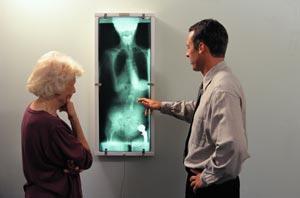
Scoliosis is any lateral curving of the spine. There are three types. The most common are the functional and congenital. Idiopathic that has no known cause and should be treated by Orthopedic Surgeons.
Congenital is one where there is a abnormal sacral base and lower lumbar vertebral that cause the spine to grow on an angle. Functional is where there is a leg length descrepancy.
Such as noted in the sketelal picture. Notice in this diagram that the right spine reveals a right short leg. Because of this the spine will now grow on an angle and compensate with a resultant scoliosis. No different that planting a sapling on an angle and watch it bend as it grows. Short leg syndrome as I like to call it can be treated very easily. But first, what are some of the causes that make one leg longer or shorter than the other?
1. Fracture of a lower extremity, ankle, knee or leg.
2. Severe sprains of the lower extremity joints that tear supporting ligaments.
3. Born with a shorter leg.
4. Excessive foot pronation/suppination.
These are the most common. In all the years of my practice I have seen were there are hereditary traits as a short leg pasted down to siblings. Ex: father has a right short leg of 7 mm, upon examination his daughter has a right short leg 7mm. Caught early enough this child may not have had a scoliosis.
WHAT TO LOOK FOR:
1. Child may appear to lean to one side.
2. One shoulder blade may be higher or prominent.
3. One hip may be higher or prominent.
4. The rib cage may appear to stick out on one side or in the back as a hump.
5. Arms hanging down at the side may show more space between the arm and body on that side.
6. Head tilt to one side, uneven hems, waistbands and uneven bra straps.
WHAT TO DO:
A discrepancy in leg length during growth will cause a tilted sacral base, with a lumbar curvature. Once again, the scoliosis is mild, but the underlying cause should be identified and corrected in order to allow balanced growth. If there is an anatomical difference in the length of the legs, a heel lift (or sole lift, in some cases) should be supplied. A child with a scoliosis must receive a careful spinal examination to determine the cause of the lateral curvature. In all cases, an assessment if the alignments and lengths of the lower extremities must be included. Accurate, standing x-ray films are also necessary; first, to measure the amount of lateral deviation, rotation, and angulation of vertebra, second, to determine spinal maturity ( and risk of progression); and finally, to rule out any leg length inequality.
Our office is dedicated to helping our patients and loved ones to help prevent the development of spinal scoliosis during early childhood. Call to schedule an appointment. Call us today 508-481-1133







